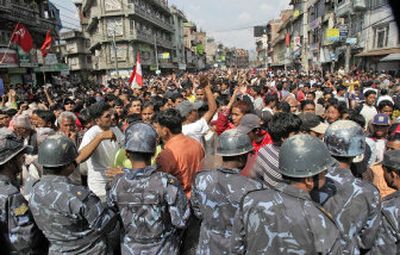Protesters in Nepal united only by their disdain for the king

KATMANDU, Nepal – The protesters crowding a Katmandu road in a whistling, seething mass Sunday clearly were unified in their quest to force Nepal’s king from power.
They roared in approval as a straw effigy of King Gyanendra was burned. They cheered demonstrators who dared to confront police. They chanted for a return of democracy and an end to royal rule.
“Gyanendra go now!” they shouted.
But that is where their agreement ends.
Watching the demonstration from the stump of a roadside tree, chopped down recently by protesters to create a roadblock, a young lawyer saw little but contradiction.
“These people don’t agree on anything – only that the king should be gone,” said Khamraj Khadka, 26, waving his hand at the 5,000 or so protesters.
Two weeks of demonstrations regularly have brought tens of thousands into the streets around Katmandu and smaller crowds in other cities across this Himalayan nation. But under that surface unity is a deeply fractured political scene.
Politicians ousted when the king seized absolute control in February 2005 want their power back with a restored parliament, but they are widely despised for ineffectiveness and corruption.
Maoist rebels want to end generations of feudal-style rule, but they have a long history of brutality in areas under their control.
And many in the crowds of demonstrators know they have had enough of their king, but they have thought little about what could come after.
The political parties and the Maoists – although recent allies in a campaign to oust the king – have been bitter enemies for years and still openly trade insults, leading many observers to worry that Nepal could descend into chaos.
While the king is desperately isolated, sealed behind the red brick walls of his palace and kept in power only by the loyalty of his security forces, his opponents don’t bother to hide the fact they barely can stand one another.
“Do I trust the Maoists? Of course not – at least not completely,” said Jhala Nath Khanal, a top official of the Communist Party of Nepal and a key intermediary between the opposition’s seven-party alliance and the guerrillas. “They talk about democracy now, but violence is a part of their philosophy,”
The feelings are mutual.
“The very character of the seven-party leaders fluctuates,” Matrika Prashad Yadav, a high-level Maoist leader arrested in 2004, said in a jail interview. “If they’re talking to the foreign powers, they say one thing. If they talk to us, they say another thing. … So the people do not trust them.”
Still, the groups have worked together effectively since late last year. Together, they have organized more than two weeks of protests and a general strike that has brought much of normal life to a halt and left Gyanendra badly weakened.
When the king tried to calm the situation Friday by offering to restore multiparty democracy, his opponents – Maoists, politicians and protesters – scoffed.
Nepal has become, in many ways, a nation of political cynics.
Many Nepalis supported the king when he seized power, saying he had to bring order to a chaotic, corrupt political scene and defeat the Maoists, whose 10-year insurgency has left more than 13,000 people dead.
Few people had been impressed by Nepal’s 15-year experiment with democracy under a constitutional monarchy, when power regularly was traded among a tiny clique of politicians. During their rule, Nepal remained one of the world’s poorest and least-developed countries. A third of its people live in poverty, and less than half of all adults are able to read.
However, Gyanendra did no better as an autocrat. The insurgency grew worse after he took power, and the economy stumbled badly. His initial support evaporated.
“We don’t have good leaders in Nepal. I wish we did,” businessman Gaura Shankar said as he watched from the fringes of Sunday’s demonstration. “All they want to do is become the boss.”
He noted that no opposition leaders actually were marching in the protests.
Clearly responding to such criticism, the seven-party alliance is calling for even bigger demonstrations Tuesday and says party leaders will head the marchers.
Despite the divisions, even cynical Nepalis say the protests are important.
Ranjan Sapkota, a 27-year-old doctor marching Saturday, said the demonstrations might prove that Nepal’s people can shape their political future.
“Right now, the most important thing is to get rid of the king,” he said.